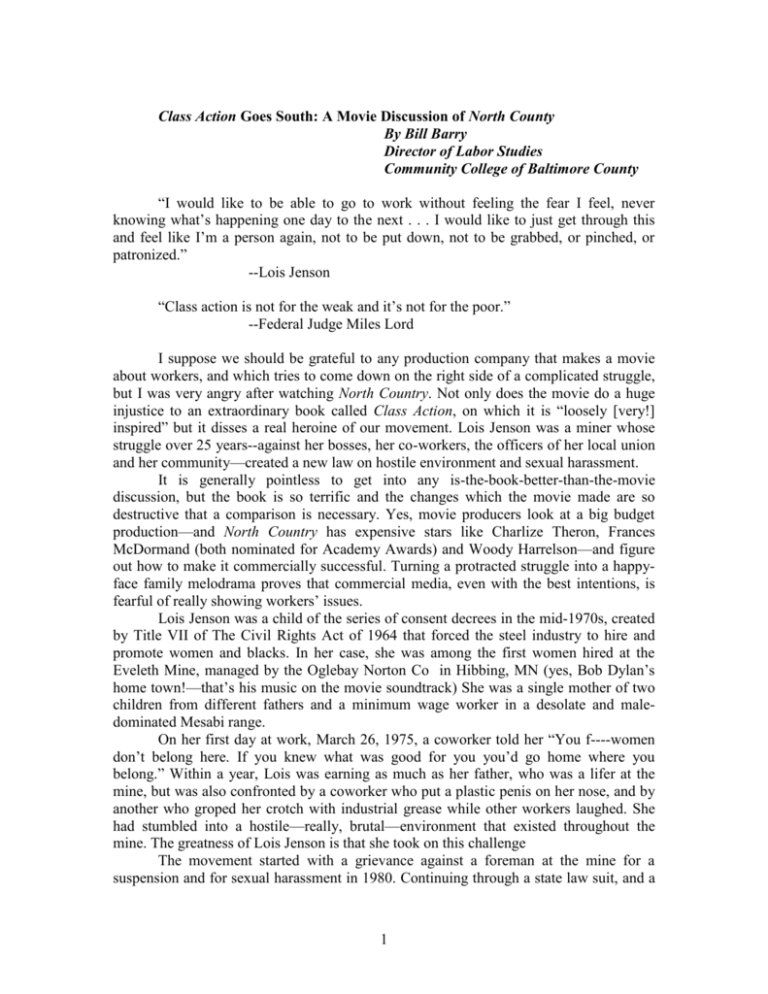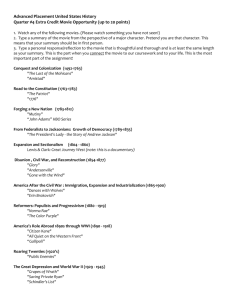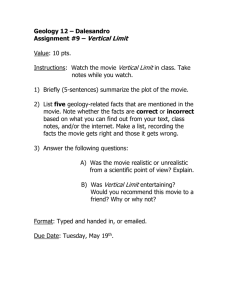
Class Action Goes South: A Movie Discussion of North County
By Bill Barry
Director of Labor Studies
Community College of Baltimore County
“I would like to be able to go to work without feeling the fear I feel, never
knowing what’s happening one day to the next . . . I would like to just get through this
and feel like I’m a person again, not to be put down, not to be grabbed, or pinched, or
patronized.”
--Lois Jenson
“Class action is not for the weak and it’s not for the poor.”
--Federal Judge Miles Lord
I suppose we should be grateful to any production company that makes a movie
about workers, and which tries to come down on the right side of a complicated struggle,
but I was very angry after watching North Country. Not only does the movie do a huge
injustice to an extraordinary book called Class Action, on which it is “loosely [very!]
inspired” but it disses a real heroine of our movement. Lois Jenson was a miner whose
struggle over 25 years--against her bosses, her co-workers, the officers of her local union
and her community—created a new law on hostile environment and sexual harassment.
It is generally pointless to get into any is-the-book-better-than-the-movie
discussion, but the book is so terrific and the changes which the movie made are so
destructive that a comparison is necessary. Yes, movie producers look at a big budget
production—and North Country has expensive stars like Charlize Theron, Frances
McDormand (both nominated for Academy Awards) and Woody Harrelson—and figure
out how to make it commercially successful. Turning a protracted struggle into a happyface family melodrama proves that commercial media, even with the best intentions, is
fearful of really showing workers’ issues.
Lois Jenson was a child of the series of consent decrees in the mid-1970s, created
by Title VII of The Civil Rights Act of 1964 that forced the steel industry to hire and
promote women and blacks. In her case, she was among the first women hired at the
Eveleth Mine, managed by the Oglebay Norton Co in Hibbing, MN (yes, Bob Dylan’s
home town!—that’s his music on the movie soundtrack) She was a single mother of two
children from different fathers and a minimum wage worker in a desolate and maledominated Mesabi range.
On her first day at work, March 26, 1975, a coworker told her “You f----women
don’t belong here. If you knew what was good for you you’d go home where you
belong.” Within a year, Lois was earning as much as her father, who was a lifer at the
mine, but was also confronted by a coworker who put a plastic penis on her nose, and by
another who groped her crotch with industrial grease while other workers laughed. She
had stumbled into a hostile—really, brutal—environment that existed throughout the
mine. The greatness of Lois Jenson is that she took on this challenge
The movement started with a grievance against a foreman at the mine for a
suspension and for sexual harassment in 1980. Continuing through a state law suit, and a
1
federal case, Lois Jenson eventually headed the lawsuit that established for the first time
that a company could be legally liable for a hostile work environment for a whole group
of workers, a class, and not just for one individual at a time.
The conflicts were dramatic enough in real life, as every organizing campaign is.
The women struggled with everything and everyone: with their backgrounds, with each
other as women dropped in and out of the ordeal, with their families and the community,
their bosses and, of course, with the men in the mine. Some of the women tried to ignore
the hostility, some took the boys-will-be-boys attitude, and several women even
circulated a petition against the law suit.
Due to some copyright issues, the movie changed the names of the women (Lois
Jenson becomes Josey Aimes and Pat Kosmach is renamed Glory Dodge) and the time
frame is dramatically shortened but there are major shifts that may be more than simple
commercial compromises.
The movie’s most offensive change is to take away the women’s struggle and to
portray it as a cause that succeeded because men began to carry it. In the process, the
movie fabricates whole new characters and family situations which are beyond even the
usual Hollywoodization, and which eat up valuable running time in bogus side dramas. In
the movie, it is the men—Josey’s father, Glory’s husband, the lawyer, even Bobby
Sharp—that move the action and get much of the attention.
Let’s look at some specific examples:
In the movie, Lois’ father is a drama in himself. He is at first hostile to her for not
disclosing the father of her son (in the book, the fathers of both of her children are
known) and for working in the mine. Eventually, in one of the movie’s most emotional
scenes, he stands up for her at the local union meeting, and a Glorious Reconciliation is
achieved. In real life, Lois’ parents had moved to Las Vegas and apparently provided
little support during her struggle. The movie also spends unnecessary time on the
protective actions of Josey’s mother, played by Sissie Spacek, who 25 years ago played
another heroic working class woman in Coal Miner’s Daughter.
Beside Lois, the most compelling figure in the book is Pat Kosmach, a single
mother of five who was an officer of the union when Lois was hired. Separated from her
alcoholic husband, her agony was deepest because she was “a fiercely loyal union
member and officer.” She wavered in her support for Lois, torn by her loyalty to The
Union, a dislike of Lois personally and a sense of the hazards of “getting involved.”
When Lois proposed establishing women’s committee in the local, Kosmach denounced
her, claiming a committee would be “a big gossip session.”
Eventually she became the strongest supporter of the law suit, even while she was
dying of ALS. By the time of her death in 1994, she had lived longer with the ALS than
anyone anticipated, and her daughter felt Kosmach had willed herself to stay alive just to
see the completion of the law suit. In the end, Kosmach was so bitter that she ordered that
no one from the union or the company be allowed at her funeral service.
In the movie, Glory Dodge has no children but is happily given a kind and loyal
husband, complete with a basement workshop (doesn’t every strong woman have a
loving hubby with a workshop at home?) He becomes a father figure as well to Josey’s
movie son—a relation wholly created in Hollywood. There are touching scenes, in the
workshop and in local bars that show the husband as A Good Guy who makes it
financially and emotionally possible for Glory to continue the struggle.
2
Another wholly imaginary—and very unpleasant--track concerns a miner named
Bobby Sharp, who did not exist in real life. In the movie, he was Josey’s high school boy
friend who watches, in a newly-created scene, the rape of Josey by their high school
teacher. In time, Bobby becomes a coworker and one of her most aggressive harassers,
but you wonder—what were these writers thinking of when they dropped this whole plot
line into the movie? Box office? Pop psychology? There were plenty of men who
harassed Lois Jenson—some of them so perverted that they broke into her house or
stalked her at work—that could have been used in the movie. The rape scene does,
however, allow one more glorification of male power: in a courtroom scene, the male
lawyer, oozing testosterone, taunts Bobby with the dilemma:”yellow ice” or “red ice.”
C’mon.
In real life, Lois was represented by a lawyer named Paul Sprenger, who made a
career—and a very lucrative living—out of getting companies to settle under threat of a
lawsuit. Sprenger did not really want to take the case to a trial which would last for ten
years and cost millions of dollars but took on the challenge and stayed with it. In the
movie, the lawyer is more dramatically portrayed as a single attorney with a troubled
past. In fact, an unnecessary amount of the movie’s limited time is devoted to scenes of
Woody Harrleson, playing lawyer Bill White, moping around local bars about his divorce
and his loss of fame as a college hockey star. In a way, the movie is as much about his
recovery from a troubled past as it is about Josie’s grit, and the movie suffers for the
change.
The movie collapses all of the legal proceedings into a short and dramatic trial in
which a stern but ultimately sympathetic judge grants Josie the class action status she
wants. It may be great for the movies but, like the TV show Law and Order, squeezing
years of desperate legal events into a short and satisfactory scene gives a distorted sense
of the emotional endurance necessary for such a struggle. In real life, Lois’ legal case
took almost 15 years to finish and was handled by a series of judges who frustrated her
by their opinions and their delays. It is often convenient for a movie to use courtroom
scenes to play on, but Class Action is about organizing, which leads to some legal
activities, and not just about the legal pleadings.
Another male who becomes important in the movie is the mine superintendent. In
one scene, he greets Josie with good humor while she is having breakfast with her
children and offers an “open door” policy. He subsequently shuts the door when she
comes to complain about harassment, offering instead—in the same condescending but
kindly tone—to allow her to resign, to quit--the one word not in her vocabulary. In real
life, the mine’s director of personnel, Bob Raich was “one of the most despised
employees,” a man whose “beliefs were very deep and very backward.” In one scene in
the book, Lois sees him at a local bar, pawing women on the dance floor.
The most distressing, even disgusting, change is the ending of the movie, which
suffocates the audience with warmth and fuzziness. After a happy hockey shoot-around
with her son, (while the MORE RECONCILLIATION sign flashes subliminally) the
lawyer says to Josey “Well I guess you got a lot of money,” [flashback to Erin
Brockovich, another working-class woman who shows nerve and takes in $1 million].
Josey flips him a warm, almost flirtatious smile and drives off with her son. After all, we
are a country of family values, are we not? In real life, Lois’ son had a tough adolescence,
suffered a major workplace injury and eventually moved to Nevada with his grandparents
3
while her daughter, whom Lois out up for adoption as a child, refused to reconcile with
her.
In real life, Lois Jenson and her coworkers were like survivors of a 25-year siege,
broken physically and emotionally. There were bitter squabbles over the money,
especially from the family of Pat Kosmach, who died before the settlement. Lois suffered
from PTSD and other health problems for which no amount of money can compensate.
Yet it is this struggle and this sacrifice that makes her the heroine that she is.
One woman, Marilyn Greiner, who testified for Lois Jenson and was portrayed by
company lawyers as a “disaffected, bitter, immoral woman,” carried a picture of her
granddaughter during the trial in Duluth. She would look at the photo and say “I am
doing this for her.”
One of the most discouraging aspects of the story is the resistance—brutal and
physical in some cases—of the officers of the Steelworkers local. Their despicable
activities almost—almost—makes me ashamed to be part of the “movement,” just as we
felt disgusted over the racial exclusion of 30 years ago. Whenever there is an opportunity
for Local President Stan Daniels to stand up for the women, he generally attacked them.
In October, 1988, Daniels proposed a settlement of the grievance to the company but the
corporate office of Oglebay-Norton responded, “f—‘em,” so Daniels helped prepare the
company’s defense against one of his own members.
After hearing for years about the attacks on the female members, Daniels testified
for the company in May, 1991, that he was “unaware of the kind of language and
materials the women complained about.” At this hearing, a company personnel officer
claimed that a grievance filed by Lois Jenson in 1984 (filed seven years previously) “was
still pending.” At another key point, Daniels publicly accused the women of “suing the
local union for all of its money.”
In a memorable exchange with his sister-in-law, Kathy O’Brien over portable
toilets for the women, Daniels stated: “If you want to work like a man, you got to learn to
piss like a man and, if you can’t, go home and bake bread.” One powerful scene from the
book which was taken literally into the movie depicted the men tipping over a portable
outhouse—with a female miner inside!
A more defining moment for the union was the demand for Chief Steward
Clarence Cadeau to file a grievance on sexual harassment. He refused, claiming that he
did not know how to do it. A coworker reminded him that he had recently attended a
workshop at the union summer school on filing sexual harassment grievances. So much
for worker education!
The despicable aspect was the officers’ insistence on “union solidarity”—while
the members were brutalizing their female coworkers, the officers demanded a code of
omerta in the name of the workers’ movement. The officers insisted that filing a
grievance on sexual harassment was a violation of the union membership oath. This issue
became especially controversial in January, 1989, when the original lawsuit was amended
to include the union as a defendant, and Daniels and the other officers ran around the
mine claiming that Jenson would bankrupt both the local and its individual members.
Not all women supported the cause. Their main antagonist, Mary Stumo, an
attorney for the Minneapolis firm of Faegre & Benson, dragged each of the women
through mud and slime to try to disprove their claims of sexual harassment, using the
“nuts and sluts” attack. She repeatedly asked them about the most intimate moments of
4
their difficult lives—many of the women were single mothers and several had been both
raped and sexually abused as children—to try to win the case for Olglebay. Today, if you
look at her credentials, she boasts of being a member of the law firm’s management
committee (the firm proclaims on its website a support for Habitant for Humanity!) and a
proponent of the firm’s commitment to diversity.
For students of workers culture, the influences on Lois and her union sisters are
extensive. Not only did she draw strength from a 1987 law suit in her area against K-Mart
in 1987, and from the Meritor Savings Bank v Vinson legal precedent, but Lois had seen
the movie 9 to 5, intently watched the Anita Hill hearings and, in her most desperate
moments, worried about being “silkwooded.”
All of this criticism is not to totally ignore the power of the movie. Many people
who have seen the movie but not read the book were moved by it. There are powerful
scenes and, on its own, North Country is a compelling story with impressive
performances and production work. The sense of working-class life—the houses, the
meetings, the turmoil--is well-done, and the sense of violence and terror inside the mine
is vividly portrayed. One UAW member said, however, that he would recommend
showing the movie at a local union meeting only to encourage the other members to read
the book.
In discussing the transformation of a powerful book into a sentimental movie,
many friends have chipped in opinions, especially about the difficulty of getting
commercial movies made about working-class topics. A deeper problem is the failure of
workers to support workers’ culture; none of the students in my labor studies classes—all
bright and eager union members--and very few friends, paid cash on the bar to see the
movie (a few are now catching up with it on DVD) and none had read the book except as
a class assignment. The loss of worker culture is a symptom of the loss of a workers’
movement but the more profound problem should not cut off discussions of specific
productions like North Country and Class Action in worker education classes.
The theme for History Day in 2006, for which middle-school and high school
students create projects and compete in every state, was “Taking A Stand.” Lois Jenson
would have been a magnificent choice. As would Sheila White.
August, 2006
5








